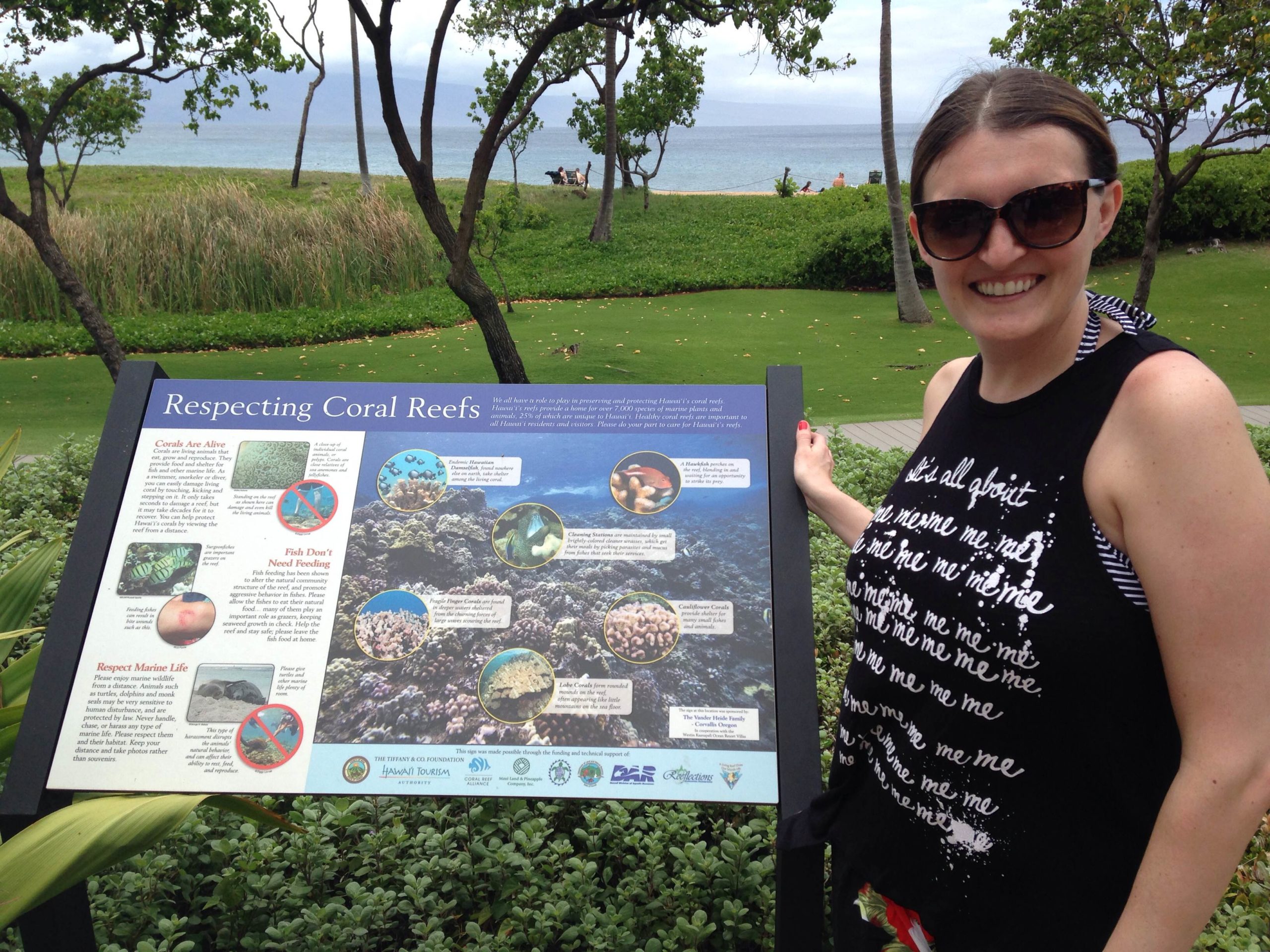 After writing about West Maui for over five years as CORAL’s grants manager, I finally had the opportunity to visit the island on a recent vacation. I got to see first-hand how West Maui’s hotels and resorts are literally the last line of defense for adjacent coral reefs. Driving the North Loop Coastline Road Hwy 30, you are feet away from the ocean; as you approach Lahaina, resorts grow in size and grandeur, hugging every inch of land to maximize beach access. One of the highlights of driving this road—for the inner CORAL-geek in me—was seeing several of our Respecting Coral Reefs signs. Not only was there one at the hotel I was staying at, but I also saw signs at many of the beaches I visited or drove by. CORAL has helped install more than 50 of these signs throughout the Hawaiian Islands, educating snorkelers and beachgoers about the many types of coral and marine life they may encounter and providing tips on how to enjoy the reefs without damaging them.
After writing about West Maui for over five years as CORAL’s grants manager, I finally had the opportunity to visit the island on a recent vacation. I got to see first-hand how West Maui’s hotels and resorts are literally the last line of defense for adjacent coral reefs. Driving the North Loop Coastline Road Hwy 30, you are feet away from the ocean; as you approach Lahaina, resorts grow in size and grandeur, hugging every inch of land to maximize beach access. One of the highlights of driving this road—for the inner CORAL-geek in me—was seeing several of our Respecting Coral Reefs signs. Not only was there one at the hotel I was staying at, but I also saw signs at many of the beaches I visited or drove by. CORAL has helped install more than 50 of these signs throughout the Hawaiian Islands, educating snorkelers and beachgoers about the many types of coral and marine life they may encounter and providing tips on how to enjoy the reefs without damaging them.
These signs are just one way we are working to engage local stakeholders and visitors alike; more recently, we have expanded our engagement to address water use and land-based sources of pollution. In West Maui, dozens of hotels are partnering with us, keen on learning what role they can play in reducing their use of fresh water and increasing their sustainable business practices. To date, Maui hotel properties have implemented over 30 sustainability projects from energy and water reduction initiatives, to landscaping best management practices, to guest and employee outreach.
 One outing that really brought the issue of land-based sources of pollution to light for me was a trip to Ho’okipa Beach on the north shore of Maui. The beach is a great place to watch surfers and we had stopped in to marvel at all the talent on demand. From the lookout point, we soon realized there were other creatures vying for our attention: several Hawaiian green sea turtles (Honu) were making their way to a quiet corner of the shore to bask, a rare behavior documented only in Hawai‘i and Australia. As many as 70 turtles have been recorded at one time. The Hawai‘i Wildlife Fund maintains a presence on this beach to ensure that the turtles are not disturbed by excited fans.
One outing that really brought the issue of land-based sources of pollution to light for me was a trip to Ho’okipa Beach on the north shore of Maui. The beach is a great place to watch surfers and we had stopped in to marvel at all the talent on demand. From the lookout point, we soon realized there were other creatures vying for our attention: several Hawaiian green sea turtles (Honu) were making their way to a quiet corner of the shore to bask, a rare behavior documented only in Hawai‘i and Australia. As many as 70 turtles have been recorded at one time. The Hawai‘i Wildlife Fund maintains a presence on this beach to ensure that the turtles are not disturbed by excited fans.
Descending from the lookout point to get a closer look, it didn’t take long to notice that one of the turtles was covered in tumors. According to Wild Hawai‘i, fibropapillomatosis is a non-malignant tumor-forming disease first discovered in Hawai‘i in 1958. Initially the disease was found only in green turtles, but it is now spreading to other species worldwide. It is the leading cause of death in green turtles. The direct cause/link is uncertain, but recent studies by Duke University, the University of Hawai‘i, and the National Oceanic and Atmospheric Administration indicate that the disease is more prevalent in areas where there is an excess of nitrogen runoff from land. While humans do not seem to be affected by this virus, turtles are the prime victims of this excess pollution; their only source of food is the nitrogen-polluted algae, which ultimately leads to these debilitating tumors and premature death.
As CORAL’s grants manager, I have written countless proposals discussing threats to coral reefs; many of these threats degrade reefs over time, dispelling some of the urgency to act now, as the impact isn’t always clear or immediate. Seeing this turtle first-hand highlighted a clear connection between land-based sources of pollution and the health of the marine environment. Our reefs—and our turtles—are literally dying, and if we don’t fix the problem at the source soon, we may have no marine life left to save.
